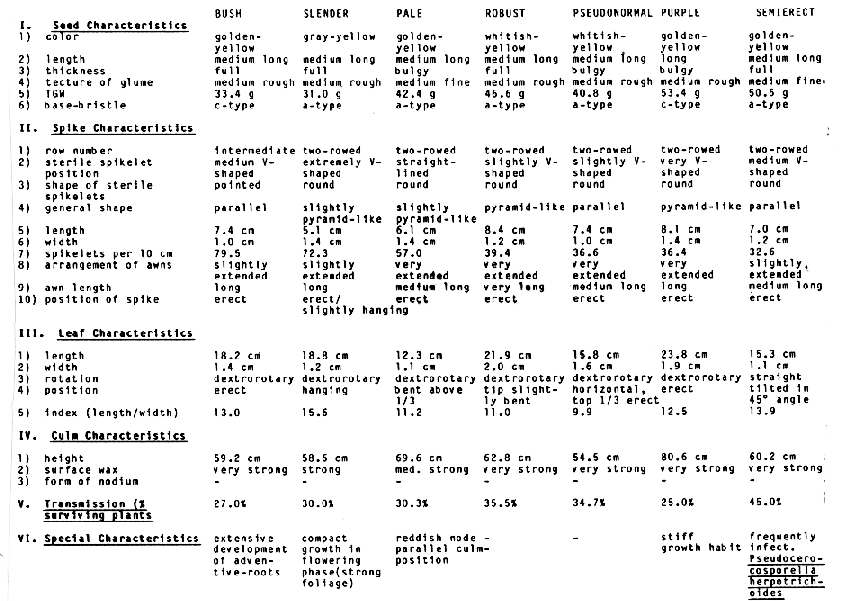

Trisomics of diploid plants like barley (Hordeum vulgare L.) are very useful for assigning new genes to chromosomes (i.e., linkage groups). Accordingly, we are presently engaged in an approach to localize the gene(s) for resistance to Barley Yellow Mosaic Virus (VaYMV) in various Asian and European barley cultivars, e.g., the German winter barley cvs. 'Birgit', 'Franka', 'Ogra', 'Diana', 'Gloria' and 'Sonate' (cf. Friedt and Foroughi-Wehr 1987).
Trisomic strains were provided by Drs. R. Takahashi and T. Konishi, Institute for Agricultural and Biological Sciences, Okayama University Japan, and by Dr. T. Tsuchiya, Department of Agronomy, Colorado State University, Fort Collins, USA. The former set of trisomics had been obtained from Hordeum spontaneum and the latter series was derived from 'Shin Ebisu 16'. Analogue trisomics of both series exhibit similar morphological characteristics in spite of their different origin. These characteristics have already been described in detail by Tsuchiya (1958, 1963, 1967, 1969). Due to their gross morphology, trisomics have been named as Bush (chromosome 1), Slender (chromosome 2), Pale (chromosome 3), Robust (chromosome 4), Pseudonormal (chromosome 5), Purple (chromosome 6) and Semierect (chromosome 7). In order to provide a more detailed description of the different trisomics for an easier recognition in applied genetic analyses we have taken additional measurements and observations of the H. spontaneum and 'Shin Ebisu 16' trisomics, as summarized in Table 1 and 2.
In general, the different trisomics from H. spontaneum are relatively similar to each other, whereas trisomics of 'Shin Ebisu 16' show clear morphological differences, just as described by Tsuchiya (1958). Therefore, it is possible to recognize the common origin of the different H. spontaneum trisomics, while this is not the case for the 'Shin Ebisu 16' trisomics. Each trisomic of 'Shin Ebisu' clearly deviates from the original phenotype. These deviations are obvious, not only regarding the growth pattern in general, but also the spike morphology. Spikes of the H. spontaneum trisomics are, in general, not as much differentiated as those of 'Shin Ebisu 16' trisomics. Whereas spikes of the H. spontaneum line are parallel and very narrow with brittle rachis, the spikes from the 'Shin Ebisu 16' series are very different from each other.


The following peculiar spike morphology of the latter series of trisomics can be distinguished (cf. Fig. 1).
Such a detailed description of characters of barley trisomics gives some indication for localization of relevant genes on the respective triplo-chromosome. Furthermore, the detailed knowledge of characters of trisomics can be very helpful in practically using trisomics for genetic analyses of important agronomic characters, e.g., disease resistances like mildew- or BaYMV-resistance. Obvious phenotypic differences between trisomic and diploid individuals can help to identify trisomics without cytological examination and, consequently, larger numbers of segregating progenies can be tested in a given time interval.
References:
Friedt, W. and B. Foroughi-Wehr. 1987. Genetics of resistance to barley yellow mosaic virus. In: Proc. 5th Int. Barley Genet. Symp., Okayama, Japan, 1986. (In press).
Tsuchiya, T. 1958. Studies on the trisomics in barley, I. Origin and the characteristics in Hordeum spontaneum C. Koch. Seiken Ziho 9, 69-86.
Tsuchiya, T. 1963. Chromosome aberrations and their use in genetics and breeding in barley - trisomics and aneuploids. In: Proc. lst. Int. Barley Genet. Symp., Wageningen, 116-150.
Tsuchiya, T. 1967. The establishment of a trisomic series in a two-rowed cultivated variety of barley. Can. J. Genet. Cytol. 9, 667-682.
Tsuchiya, T. 1969. Status of studies of primary trisomics and other aneuploids in barley. Genetica 40, 216-232.
Legend
Figure 1. Spike morphology of trisomics derived from Hordeum vulgare cv. 'Shin Ebisu 16' ('S.E.') . Page 1: 1S.E.1 (top left), triplo 1 (top right), triplo 2 (bottom left), triplo 3 (bottom right). Page 2: triplo 4 (top left), triplo 5 (top right), triplo 6 (bottom left), triplo 7 (bottom right).